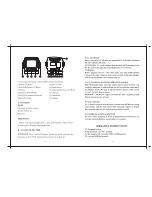
Sageon III Power System
Configuration and Operation
PM990-8800-00, Rev. 9
4-13
4.7
BATT MENU SCREENS
Enter this series of menus by pressing the BATT button. Press the “up arrow” button to scroll through the screens in the order
presented. Repeat the series for each battery string. The following map summarizes the available menu screens.
BATT Button
Battery string (1-4) current*
Battery string temperature
Estimated charge (1-4)
Programmable
Battery discharge alarm voltage
Battery temperature alarm
* Press ENTER to
Battery Ah rating
read individual cell
BTC on/off
voltages if SBM
BTC Temperature coefficient
option is installed
BTC Temperature compensation nominal
and enabled.
Number of cells per string
Battery charge current limit: <Vdd
Battery deep discharge voltage: Vdd
Battery charge current limit: from Vb<Vfl
System float voltage
System voltage drop
Equalization on/off
Charge current limit: >Vfl
Equalization voltage
Equalization trigger voltage
Equalization no trigger voltage
Equalization trigger charge: Ah
Equalization trigger discharge rate: Ah
Equalization no trigger discharge rate: Ah
Equalization end charge current
Equalization end charge: Ah
Equalization end duration: hours
Equalization auto-initialize: weeks
Equalization end: manual
Equalization start: manual
LVDS trip voltage
LVDS mode: auto/closed/open
Temperature sensor alarm on/off
Discharge current and battery voltage
BDT period: 0-365 days
BDT start time: hours, minutes
BDT duration: hours, minutes
BDT current: 0-5000A
BDT end voltage
BDT end charge: Ah
BDT alarm reset
BDT end, manual
Last BDT results: pass, fail, abort, etc.
Last BDT time/date; duration
Last BDT battery string voltage and charge
IMPORTANT
: The number of the target battery string (e.g. Battery
1
) must be entered!
Complete descriptions for testing vented lead
acid and VRLA batteries are beyond the
scope of this manual but are discussed in
detail in IEEE STD-450-2002 (or its latest
revision) and IEEE 1188-1996, respectively,
battery specific manuals, and other
professional society standards.
It is important to recognize that standby
batteries/cells are designed for emergency
standby operation and excessive testing or
cycling of a battery can materially shorten
the life of a battery.
















































